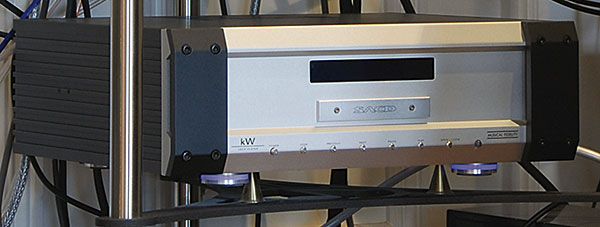Musical Fidelity Tri-Vista kWP and kW Amplifiers Page 2
Acoustic and electric basses spelt out clearly the dynamics of the vibrating strings, leaving you feeling sadly shortchanged when the bass was of a synthesised nature. This level of detail persisted even with fast basslines, suggesting there was no lack of speed underpinning the kW's muscular output.
Impact Driver
I decided to up the tempo with 'Pusherman' by Curtis Mayfield. The range of percussive instruments on this track makes it a great test for transient speed and attack. All the MartinLogan Prodigy's legendary speed was instantly apparent but, in terms of impact, the speakers were suddenly doing an impersonation of a pair of Mezzo Utopias. Dumbstruck by the sheer breadth of the kW's talents, it was time to swap the HP100 for the kWP to see what the Tri-Vista pair could do in tandem.

First track up was Steely Dan's 'Rikki Don't Lose That Number' and, by the time the marimba intro had panned across my listening room (in an arc the size of a Bath crescent), I was sold. Even just focusing on this one instrument, the kWP utterly transformed the song.
Full Disclosure
I have often found Steely Dan's studio-built extravaganzas a little lacking in depth and presence, but this time the marimba was in the room with me. Even more impressive was its appearances throughout the track. I had only ever picked up ghostly echoes of it previously, but with the kWP I could track every note, each hammer strike a separate entity, and its eerie resonance hanging in the air behind the dominant keyboards.
The kWP had a similarly illuminating effect on vocals. Just choosing one example, Jimmy Hughes' 1966 classic 'Neighbour, Neighbour', the jangling guitar, sleazy rhythm section and jabbing horns still gave the track its none-too-subtle air of menace, but what about Jimmy's vocal? Instead of the naked aggression the lyrics suggest, for the first time, I heard desperation and a hint of vulnerability. The song was the same, but now a whole new chapter of vocal nuances had opened up.
What was common to vocal and instrumental reproduction was the sheer level of information on offer. Even the simplest notes had layer upon layer of micro detail: minute tonal shifts, the subtlest hint of vibrato (intended or otherwise) and ambient hints by the bucket load, it all contributed to a quite awesome sense of presence.

Moving to a more complex instrument and things became better still; the sound of a baritone sax on one of the Opus 3 test discs stopped me in my tracks. I always thought the HP100 had a pretty good tonal palette but now the colours were positively iridescent.
Rhythm King
With the preamp's resolution well and truly proven, I had a trawl through John Mellencamp's blue collar masterpiece The Lonesome Jubilee to check out rhythmic integrity. On 'Paper In Fire', the kWP immediately locked onto the metronomic percussion which propels the track. However, it never let the cart drive the horse, and the rich sonority of the strummed banjo was allowed to develop fully, while the relaxed vocal was never hurried.
Listening to the song 'Hotdogs And Hamburgers', the preamp was agile enough to accurately track several overlaying rhythmic themes on acoustic guitar, drums and even fiddle, while never losing track of the song's overall coherence. The kWP scored very highly in the toe-tapping stakes, but the balance always leant towards the music driving the amp rather than the other way around.
Like Thunder
When assessing whether each component had any weaknesses, paradoxically it was their strengths which came under scrutiny.
In the case of the kW, its awesome power is truly intoxicating, but its ability to keep raising SPLs until the speakers give up the ghost can occasionally catch you out. Set the initial volume too high on a dynamic piece of orchestral or rock music and, when the climax comes, it's a little bit like being surprised by a really loud thunderclap – as the sound builds relentlessly, you ask yourself, 'Just exactly how loud is this going to get?'. If your neighbours are simultaneously asking the very same question, you might not have the ideal listening environment for the kW's 'loud' mode.

With the kWP, the precision and quantity of information on offer can highlight unusual production effects. Even allowing for intentional multitracking, the title of 'Here, There And Everywhere' was wholly appropriate to the location of Paul McCartney's vocal. In this case, the sheer beauty of the song carried the day, but early stereo recordings of the 'I'm over here... now I'm over here' variety can leave you a little disorientated.
Conclusion
Musical Fidelity has produced a pair of truly groundbreaking amplifiers which, in terms of overall technical performance, at least, might well be unmatched at any price. They amaze with the breadth of their talents. You really do hear your music collection anew, and the only real question is whether they're more impressive playing mellow acoustic music or blasting out orchestral crescendos.
If you're feeling particularly flush and have ever considered purchasing a really high-power amplifier, the Tri-Vista kW is a must-listen. If you want to hear it at its best, then the kWP is the obvious choice of partner. If, like me, you're wondering how long it'll take to accumulate the purchase price, the strictly limited edition status is a bit of a nuisance.
On the other hand, I have a feeling that some competing manufacturers will be mighty glad that Musical Fidelity is planning to build only 75 examples of these.


















































